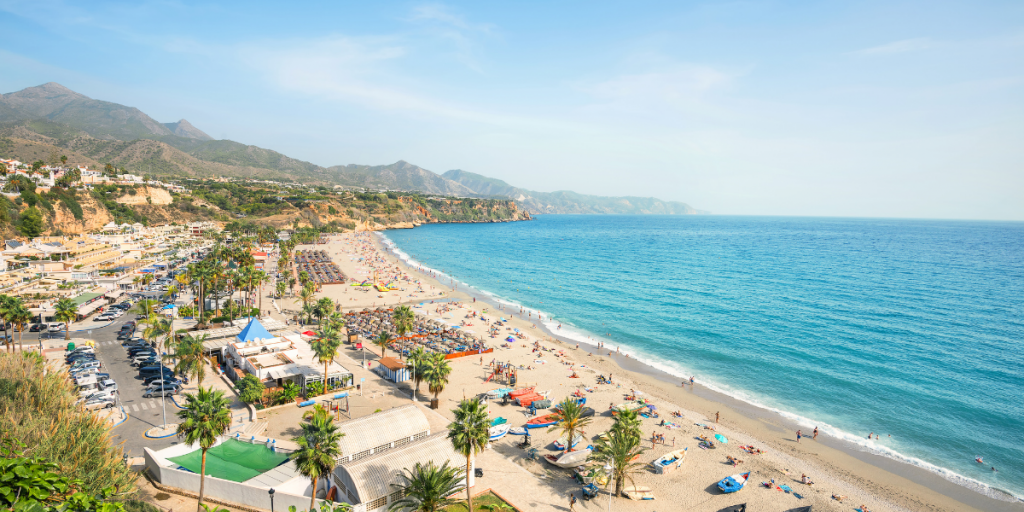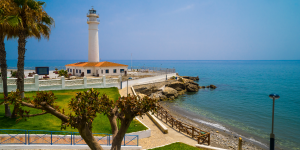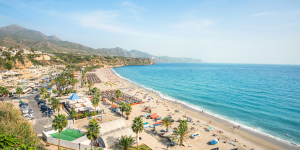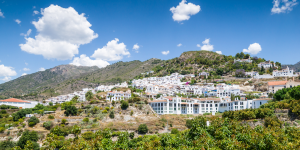Nerja, a town that preserves the roots of its Moorish past, es extremely seductive, surriunded by coves and rugged mountains. It has thirteen kilometres of beaches with the best services, excellent weather, and a lively atmosphere to be enjoyed throughout the year. Nature lovers can admire the breath-taking scenary and practice sports such as fishing, diving, wáter skiing, canoeing, hiking, biking, and horseback riding. Nor forgetting the virtues and flavour of a cousine that blends tradition and modernity all together. As for festivals, Nerja very much keeps alive traditions such as Carnival, Easter, the festival of San Isidro, San Juan, or the day of Carmen among others. Great highlight is the International Festival of Music and Dance at the Cave of Nerja, the third most visited monument in the country, recreatived in a magical world of stalactites and stalagmites.
Fish is the base of cuisine of Nerja. Among the traditional dishes are egg or almond soup, a fish dish with peppers, onio, garlic and potatoe, noddle casserole with dried beans or cabbage, fried breadcrumbs, tomate soup with clamx and sardines and fried pumpkin. Goa round its streets and visit tha tapas bars.
Handicrafts are easily found in Nerja streets. This city is famous for objets od wicker and rush, which are abundant in the area, typically making espadrilles, rope and baskets. Also, handbags, briefcases and frames made by leather and fur .
There is a lot amazing places to visit:
- Iglesia de El Salvador: This church was built in the sixteenth century and renovated later. The temple consistes of three naves, one with Mudejar mountings. An ortogonal bell tower marks its facade. Inside are the eighteenth century frescoes fron Granada school and the mral of the Announciation by Francisco Hernandez.
- Ingenio San Antonio Abad: It was a sugar factory where the remains are of special interest because of the decorative carving found on one of its wall incluing watrer and naval motifs. The remains of the mil, known as Tablones, stand next to it.
- Santuario Nuestra Señora de las Angustias: This baroque temple houses the image of the patrón saint of Nerja. It has a single nave topped with a barrel vault. Eighteenth century painting from the Granada school can be seen in the dome.
- Balcón de Europa: This is a viewing balcony located at the end of a palm tree-lined avenue. Its antient fortress dating to the ninth century, from where the coast was guardes against posible attacks from North Africa or pirates, has several guns that evoke the past of this military enclave.
- Bote “La Dorada” de Chanquete: It is one of the symbols of the town and of the legedary televisión series called Verano Azul. During the serie the boat was home to the salty old sea dog: Chanquete
- Fuente Cantarero: This fountain is a beatutiful example of urban architecture dating back to early last centruy.
- Puente antiguo: This bridge was built in 1860. It has 3 levels lined with red brick, a cobblestone road, steel railing street lighting.
- Museo Histórico de Nerja: Located in the Plaza de España, you can see the founding collection of archaeological pieces and a replica of the chapel of the Pisciformes, inside which a set of exceptional painting are drawn.
- Torres vigías: Five watchtowers used by both the nazarí and Castilian conquerors to defend the coast. Dating from the sixteenth and eighteenth centuries they have under gone several reconstructions depending on the military needs of the time.
- Acueducto Águila: This aqueduct was built between 1879 and 1880 on the Maro River to supply water to the San Joaquín sugar factory in the Mercedes Settlement.
- Cuevas de Nerja: Theses caves were declared Cultural and Natural Interest and one of the most visited natural monuments in the province of Málaga. It is also scene of Internatinal Music and Dance Festival in July. It is located at the foot of the Sierra de Almijara, has 4823 metre route and you can visit a third of the galleries. In addition to the impressive karst formations, its interior houses paintings and archaeological remains of up to 30000 years old.
- For nature lovers: Parque Natural de las Sierras Almijara, Tejeda y Alhama. It is one of the most important natural mountain enclaves un South Eastern Andalusia.Provides Infinites possibilities of adventures and nature lovers.
- Nerja has 13 kilometres of beaches. Burriana, Playazo, Torrecilla and Calahonda are the best known.





